HSS Blind Structural Fasteners
By Mike Manor, PE, MLSE
Technical Consultant, Steel Tube Institute
Connections to HSS are tricky to design and install. Welding is a common choice for attaching to HSS members, however, this requires significant cost for field installation in terms of dollars and schedule time. Bolting is an appealing alternative option to speed up field installation and remove the welding labor costs, but bolt installation can be difficult without easy access to the back side of the connection due to the closed nature of HSS members. This is where mechanical connections from one side become useful to increase the feasibility of field-installed connections other than welding. There are many options for a one-sided connection such as through-bolts, blind structural fasteners, threaded studs, and flow-drilling. STI has some information available in past articles for these situations which can be found here: link 1, link 2. This article will focus only on the category of blind structural fasteners 1) explaining the pertinent design limit states necessary to properly design the connection and 2) listing available proprietary options and how they work.
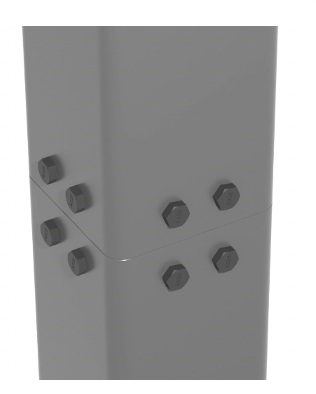
HSS Splice with Blind Structural Fasteners
What are Blind Structural Fasteners?
“Blind” structural fasteners, also known as “one-sided” structural fasteners, are mechanical fasteners that allow the connection of structural steel members to closed steel sections such as HSS tubes where installation access of the fastener is only readily available on one side of the connection. The reason this is important is that standard “two-sided” bolts require inserting the shank of the bolt through the bolt hole from one side and then installing the nut on the opposite side of the connecting element. To install this two-sided bolt connection in HSS members, the installer would need to reach inside the HSS with a hand or wrench to either install the bolt through the hole or install the nut. To tighten standard bolts, the installer must be able to hold the bolt head with a wrench while tightening with a second wrench on the nut. Twist-off tension control bolts can alleviate the tightening issue but still require access from both sides to insert the bolt and install the nut. This may be possible for a connection near the end of an HSS member, but for most locations, standard bolt installation is not possible unless a portion of the HSS wall is removed. Consequently, removal of the HSS wall face can affect member capacity and may still not provide adequate access for standard bolt installation.
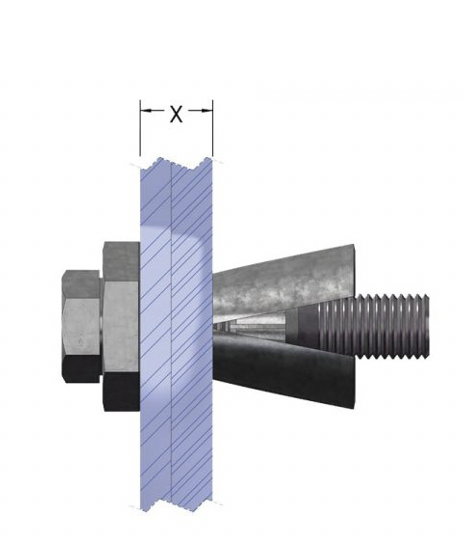
Wedge Anchor
Through various means, blind fasteners all have a mechanism that allows a bolt to be completely installed in an HSS member from the exterior side only. One system is a wedge anchor (see Figure 2) that allows an internal bolt to be tightened by using two wrenches on the same side. One wrench holds the collar/shoulder in place while the second wrench tightens the bolt head. As the bolt head tightens, a cone-shaped element at the opposite end of the bolt starts to move up the internal threads and pushes outward on the body/shell/sleeve. Once fully tightened, the bolt has expanded far enough to prevent it from coming back out of the hole while also applying pressure on the internal side of the HSS wall face and bolt hole.
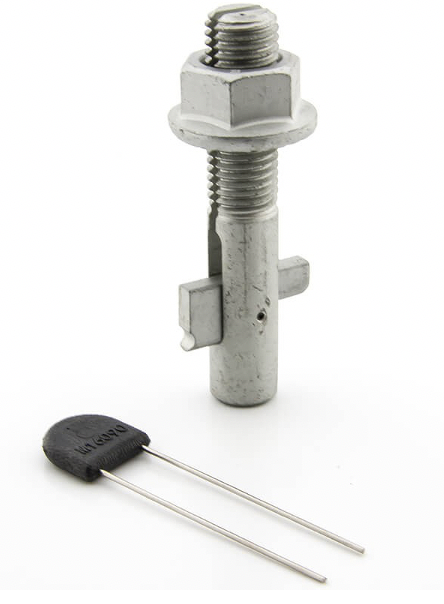
Toggle Fastener
A second type of blind structural fastener is a bolt with an internal toggle (see Figure 3). The toggle bolt is inserted into the bolt hole with a specific orientation to ensure the toggle remains inside the bolt shank. Once the nut is against the face of the connected element, rotating the bolt 180o causes gravity to flip the internal toggle 90o creating the “t” shape shown in Figure 3. The bolt can then be tightened with a single tool. As the nut turns, the threads pull the shank of the bolt outward until the toggle bears on the inside face of the HSS wall, locking the toggle bolt in place.
A third blind fastener option is a bolt that works by using a proprietary split washer with a built-in hinge (see Figure 4). This washer folds in half to fit through the hole in one orientation, then, when the assembly is rotated 180o, the washer flips and expands into place, forming a ring around the bolt shank and providing a bearing seat for the bolt head on the interior face of the HSS wall. At this point, the bolt can then be tightened with a single wrench.

Split Washer Fastener
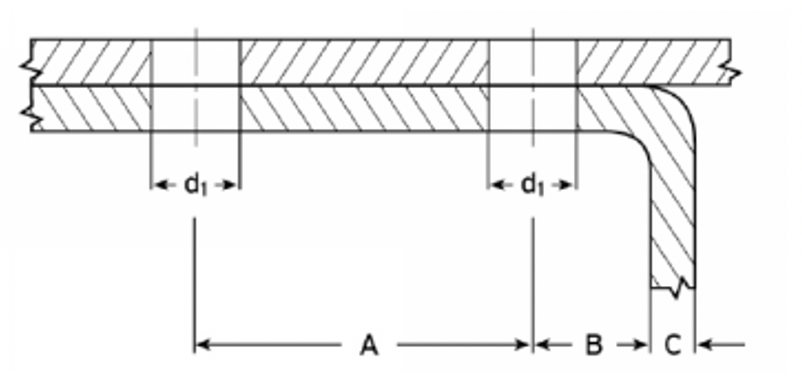
HSS Edge Distance and Spacing
A fourth type of blind fastener requires placing the nut of a standard, high-strength structural bolt on the inside of an HSS member or a connecting plate. The nut is generally attached to the steel member as part of the fabrication process. The nut can be directly tack welded in place or it can be held in place with a proprietary product. When tack welding the nut itself in place, two problems frequently arise. First, the nut is difficult to tack in place properly, and second, the nut cannot move, thus eliminating installation tolerance in the case of minor misalignment of the bolt holes relative to the steel plies being connected. The alternative approach is to use a proprietary product which doubles as an erection aid, holding the nut in place while allowing tolerance in the connection and acting as an internal “wrench.” This means the bolt can be tightened with a single wrench from one side of the connection. Regardless of installation method for the nut, the bolt is still a standard bolt, and the connection is designed directly with the AISC Specification and Manual. Once the bolt is completely tightened, the tack weld or the proprietary holder are sacrificial and do not transfer any of the structural load across the connection. Additionally, both options adequately secure the nut for pre-tensioning of the bolt should a slip critical connection be desired.
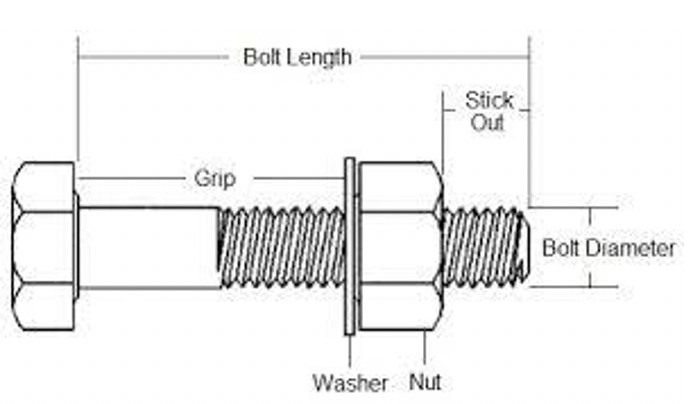
Standard Structural Bolt
General installation requirements applicable to all types of blind structural fastener addressed in this article are related to the geometry of the connection. Many of the blind fastener products have multiple lengths available for each nominal size/diameter. Each of the sizes available has a specified minimum and maximum clamping thickness, or grip (see Figure 6 for a standard bolt), that creates a range for the total steel thickness being fastened together. The total steel thickness includes both the actual thickness of the supporting HSS member plus the thickness of the steel element being supported. When selecting a blind fastener at each specific connection location, the designer must account for the grip, internal and external fastener clearance, edge distance, and spacing requirement to ensure a compatible fastener is selected that will provide the intended connection capacity. Note that some fastener products also require a minimum thickness of the element being connected. For rectangular HSS sections, the edge distance (B + C in Figure 5) must account for both the thickness of the HSS sidewall and the interior corner radius to ensure clearance of the blind fastener mechanics on the inside of the tube. If the fastener is placed too close to the HSS corner, the fastener may not seat properly and thus not fully develop the design capacity. Additionally, some products specify a minimum torque required for proper installation.
Design Limit States
All connections to HSS must be designed for the applicable limit states for both the fastener and the HSS member to ensure adequacy of the connection. When blind structural fasteners are used for connections to HSS members, the structural loads present can include dead and live gravity loads as well as wind and/or seismic loads. All of these loads are transmitted through the connection in shear, tension, or a combination of the two.
Looking first at blind structural fasteners, the pertinent limit states are shear and tension of the fastener. Most of the fasteners presented in this article have shear and tension capacities published in the manufacturer’s literature and third-party testing reports. Some of the fasteners use either standard structural bolts or proprietary bolts that meet the specifications for standard structural fasteners such as ASTM A325 or A490. In these cases, the fastener capacity can be calculated directly per Chapter J of the AISC 360-16 Specification.
For the limit states pertinent to the HSS member, there is a list of both familiar limit states for shear and some atypical limit states for tension loading. Starting with shear, the bearing and tearout strength at the bolt hole must be considered per AISC section J3.10. In the case when a connection is required near the end of an HSS member, block shear must also be considered per AISC section J4.3. Turning to tension loading, HSS has two atypical limit states to check. The first limit state to consider is the possibility of the bolt head pulling through the HSS face (also known as punching shear). AISC Design Guide 24 has guidance on this limit state in Section 3.2 (see Equation 1) for each bolt individually. The critical variable is dw which is defined as the “diameter of the part in contact with the inner surface of the HSS.” Depending on the blind structural fastener used, this could either be the head of the bolt, the washer size, the body of an expansion anchor, or the size of the toggle.

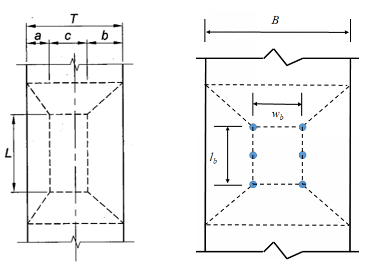
HSS Yield Lines
The final limit state for tension is Distortion which is due to the flexibility of the HSS wall. This limit state is similar to chord wall plastification for HSS-to-HSS connections in that it treats the area defined by the bolt group as the branch in a T-connection. The capacity is based on yield line theory starting with equation 9-30 from the AISC 15th Edition Steel Manual (see Equation 2). Setting the value of c equal to the bolt group width (wb) and the value L equal to the bolt group length (lb), following with the proper substitutions, the result is Equation 3. The value Qf considers the level of stress within the HSS member and is determined with AISC Specification Equation K2-3.
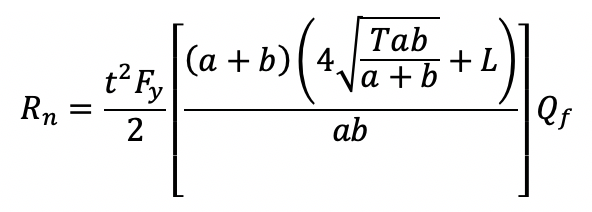
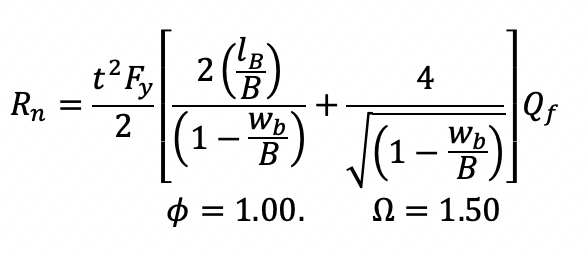
Proprietary Blind Structural Fasteners
Below is a list of proprietary blind structural fasteners intended for structural connection purposes in building-type applications. For each fastener, criteria are provided to demonstrate the design parameters under which the fastener can be used as well as where information is available. Links to installation videos are provided to aid in the understanding of how each fastener type mechanism works and how each can be physically installed from one side of the connection. This list of fasteners is intended for educational purposes only to raise awareness of connection options available for HSS members at the time this article was written and is in no particular order. The information for each product comes directly from the available resources for each fastener including the manufacturer’s literature and third-party testing reports. Contractors, engineers, or other design professionals must verify the applicability of each fastener to their particular project requirements and loading demands before specifying.
Shuriken
The Shuriken product is a steel erection aid that is considered a “disposable wrench.” The Shuriken part is tack-welded inside of an HSS member to hold a standard, high-strength nut in place during installation of a standard A325 or A490 bolt. Since the nut is held in place, the bolt can be installed from one side of the connection and tightened with a single wrench. Following installation, the Shuriken is sacrificial as the bolt transfers all the structural load through the connection. The connection fastener capacity is calculated the exact same as for standard A325 or A490 bolts.
Fastener Finish: None for Shuriken – Fastener same as standard A325 or A490 bolt
Connection Type: Bearing & slip-critical
Loading Type: Tension/shear
Load Combinations: Gravity loads, wind loads, and seismic loads (SDC A-F)
Load Interaction: AISC Specification Section J3.7 or J3.9
ICC-ES Report: N/A since the Shuriken does not transfer structural load
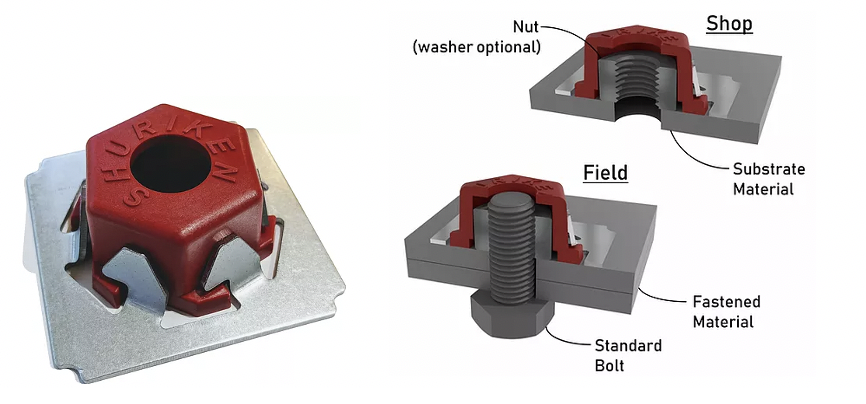
Shuriken
Manufacturer: Atlas Tube
Installation Video: View site
Product Website: View site
For more information about Shuriken, see the HSS Insider article “New Concepts for Bolted HSS Column Splices“.
Hollo-Bolt®
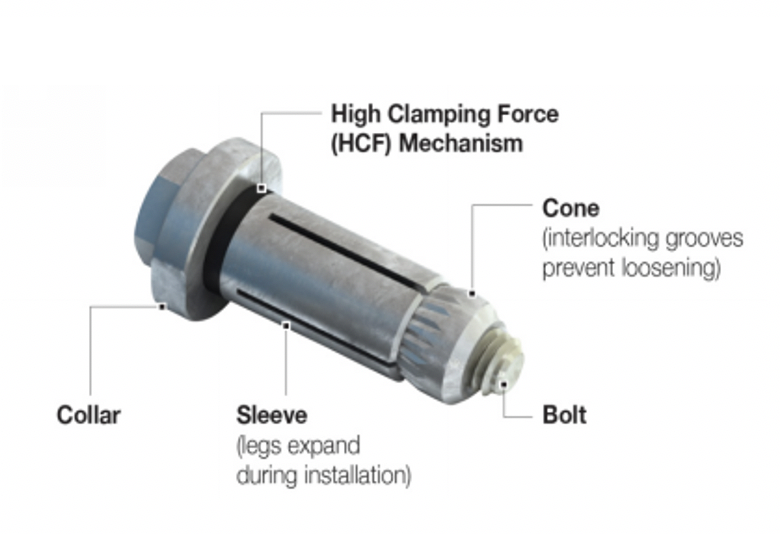
Hollo-Bolt
Hollo-Bolt blind fasteners also function as an expansion wedge bolt. The Hollo-Bolt has a hex-shaped bolt head and a circular collar with two flat surfaces to allow installation with standard wrenches. See manufacturer’s literature and ICC report for list of nominal sizes available as well as requirements for hole size, edge distance, end distance, spacing, fastener length, grip and fastener clearance. Tension and shear capacities are also noted for the fastener only.
Fastener Finish: Hot-dip galvanized
Connection Type: Bearing
Loading Type: Tension/shear
Load Combinations: Gravity loads, wind loads, and seismic loads (SDC A-F)
Load Interaction:

ICC-ES Report: ESR-3330
Manufacturer: Lindapter
Installation Video: View site
Product Website: View site
Boxbolt®
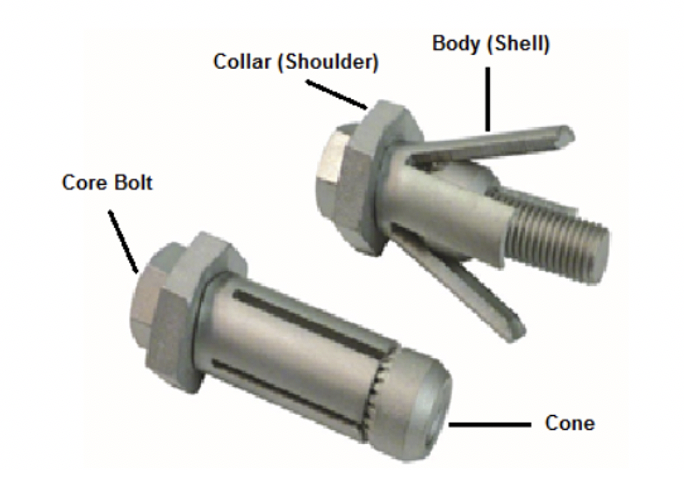
Boxbolt
Boxbolt Type C blind fasteners work as an expansion wedge bolt. The hex-shaped bolt head and shoulder allow installation with standard wrenches. See manufacturer’s literature and ICC report for list of nominal sizes available as well as requirements for hole size, edge distance, end distance, spacing, fastener length, grip and fastener clearance. Tension and shear capacities are also noted for the fastener only.
Fastener Finish: Hot-dip galvanized
Connection Type: Bearing & slip critical
Loading Type: Tension/shear
Load Combinations: Gravity loads, wind loads, and seismic loads (SDC A-F)
Load Interaction:

ICC-ES Report: ESR-3217
Manufacturer: LNA Solutions
Installation Video: View site
Product Website: View site
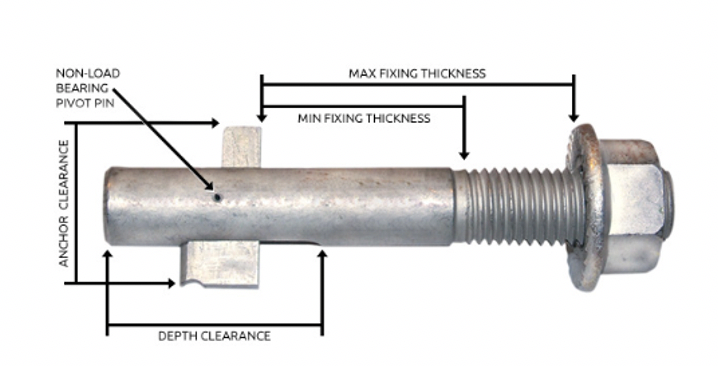
Blind Bolt
Blind Bolt
The proprietary Blind Bolt fastener is an internal toggle bolt fastener. The hex-shaped flange nut allows tightening with one wrench. See manufacturer’s literature and ICC report for list of nominal sizes available as well as requirements for hole size, edge distance, end distance, spacing, fastener length, grip and fastener clearance. Tension and shear capacities are also noted for the fastener only.
Fastener Finish: Carbon steel with zinc flake finish or Stainless steel
Connection Type: Bearing
Loading Type: Tension/shear
Load Combinations: Gravity loads, wind loads, and seismic loads (SDC A-C)
Load Interaction:

ICC-ES Report: ESR-3617
Manufacturer: Blind Bolt
Installation Video: View site
Product Website: View site
NEXGEN2™
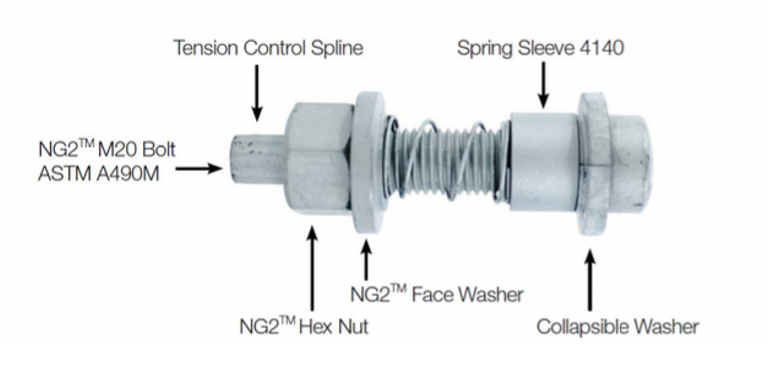
NEXGEN2
The NEXGEN2 fastener has a proprietary collapsible split washer and a steel spring which aids in installation. The core bolt is made from steel compliant with ASTM A490. A special proprietary installation tool inserts both the head of the bolt and the split washer through the bolt hole and then swings the split washer into place between the bolt head and the HSS face, allowing tightening from only one side. See manufacturer’s literature and ICC report for list of nominal sizes available as well as requirements for hole size, edge distance, end distance, spacing, fastener length, grip and fastener clearance. Tension and shear capacities are also noted for the fastener only.
Fastener Finish: Magni 554 Duplex Fastener Coating
Connection Type: Bearing
Loading Type: Tension/shear
Load Combinations: Gravity loads, wind loads, and seismic loads (SDC A-C)
Load Interaction:

ICC-ES Report: ESR-3975
Manufacturer: Allfasteners
Installation Video: View site
Product Website: View site
AJAX OneSide Fastener™
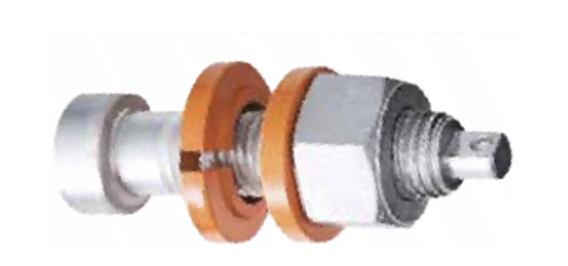
AJAX OneSide Fastener
The AJAX OneSide Fastener is bolt compliant with ASTM A325M with a proprietary collapsible split washer which aids in installation. A special proprietary installation tool inserts both the head of the bolt and the split washer through the bolt hole and then swings the split washer into place between the bolt head and the HSS face, allowing tightening only from one side. For additional shear strength, there is an option to add a shear sleeve surrounding the fastener within all plies. Bolts with and without the shear sleeve utilize the same bolt hole size. See manufacturer’s literature for list of nominal sizes available as well as requirements for hole size, edge distance, end distance, spacing, fastener length, grip and fastener clearance. Tension and shear capacities are also noted for the fastener only.
Fastener Finish: Hot-dip galvanized, Mechanical galvanized, Electroplated, Thermal Oxide (blackened), Magni (Zinc Rich)
Connection Type: Bearing & slip critical
Loading Type: Tension/shear
Load Combinations: Gravity loads, wind loads, and seismic loads (SDC A-C)
Load Interaction: AISC Specification Section J3.7 or J3.9
ICC-ES Report: No current third-party test report available
Manufacturer: Ira Svendsgaard and Associates
Installation Video: View site
Product Website: View site
Concluding Thoughts
Providing bolted connections to HSS has historically been a difficult task, however, there are many options available today. The difficult part is determining which option is the best for each particular connection. With the list of options covered in this article, designers have a starting point for determining capacities for the blind structural fastener options available based on the type of loading, geometry of the connection, and the available space. However, the most important takeaway is that welding is not the only option for connections to HSS members and, with the wide range of structural blind fasteners available on the market, there are certainly economical alternatives to consider.
References
AISC, 2016. “Specification for Structural Steel Buildings,” ANSI/AISC 360-16, and Commentary, American Institute of Steel Construction, Chicago, IL.
AISC, 2017. “Steel Construction Manual, Fifteenth Edition,” American Institute of Steel Construction, Chicago, IL.
Ericksen, J. (May, 2014). “Bolting to HSS Members,” Steel Tube Institute.
Hansen, K. (November, 2014). “Expansion Bolts for Hollow Structural Steel Sections,” Structure Magazine.
Kurobane, Y., Packer, J.A., Wardenier, J., Yeomans, N. 2004. “Design Guide for Structural Hollow Section Column Connections”, CIDECT Design Guide No. 9, CIDECT, Germany, ISBN 3-8249-0802-6
McCormick, J. (July, 2017). “Connecting Hollow Structural Section Members with Through-Bolts,” Steel Tube Institute.
Olson, K. (December, 2020). “Bolting to HSS,” Webinar, Steel Tube Institute.
Packer, J., Sherman, D. and Lecce, M. 2010. “Hollow Structural Section Connections,” Steel Design Guide No. 24, American Institute of Steel Construction, Chicago, IL.
May 2021